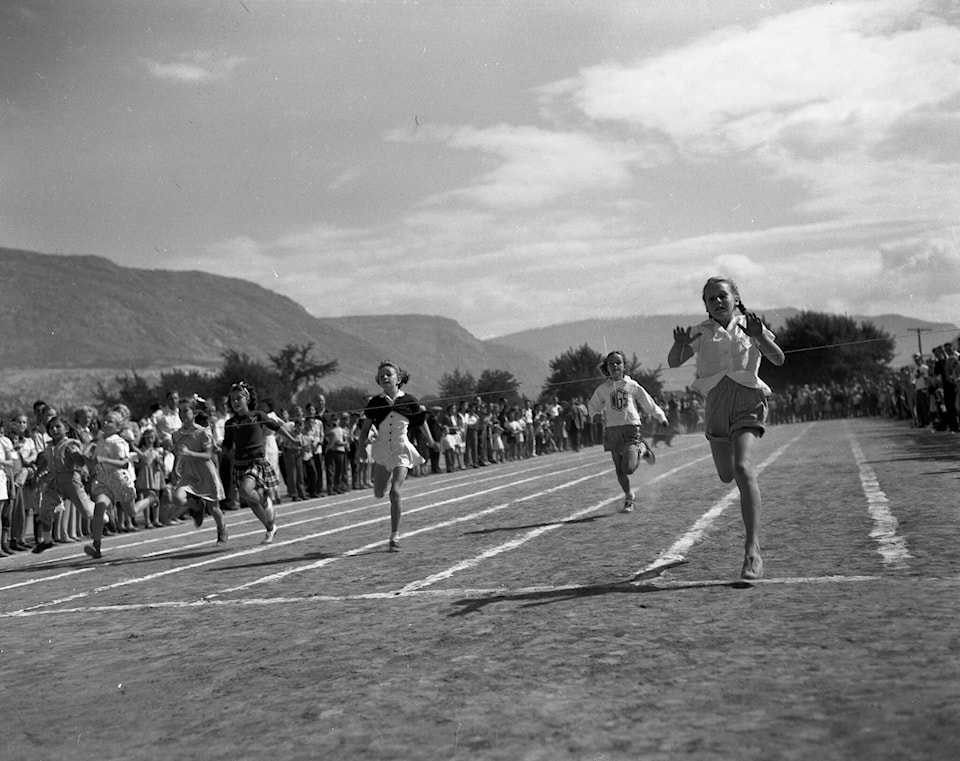Forget the latest pricey Nike sneakers and fancy athletic basewear and outerwear for the advantage.
Back in the day, these young Trail athletes wore whatever was on their back — skirts, dresses, long dress pants, suspenders — and ran like the wind to cross the finish line and win a coveted ribbon, along with an accolade or two from spectators.

Looking back at young Trail athletes from years long past is especially fitting for this week’s Trail Blazers feature given today, June 2, is the annual elementary school track meet at Haley Park.
“A long standing and noble tradition, track and field in our area has always showcased these young athletes performing at their best,” says Addison Oberg, collections coordinator for the Trail Museum and Archives. “The annual meet is held at Haley Park, named after Trail track champions, Joe and Pat Haley.”

Joe Haley
Joseph Brennan Haley (October 16, 1913 – May 1997) was born in Red Islands, Nova Scotia and lived in Pictou, Nova Scotia, before his family moved to Trail in 1925.
In 1934, Joe competed in the British Empire Games trials where he placed first in high jump and qualified to compete in the 1934 British Empire Games. At the games he won a silver medal in high jump, losing a “jump-off” for the gold medal against Edwin Thacker of South Africa.
In 1936, Joe Haley became the first Trail athlete to compete in the Olympics.
Held in Berlin that year, he finished twelfth in the Olympic high jump event.
Two years later he finished sixth in the high jump contest at the 1938 Empire Games, according to sports-reference.com.
Pat Haley
In 1936, Pat Haley competed in the Junior Olympic trials where he won the 100 metre, broad jump and high jump, setting a Canadian junior high jump record.
In the 1937 British Empire Games, Pat competed with the 4 x 110 yard relay team which won the gold medal and set a World Record.
He attended Washington State University on an athletic scholarship during the years of the Second World War. In 1940, he held the national freshman record in the 100 yards at 9.5 seconds. Three years in a row he won the Pacific Coast Conference sprint titles at 100 yards, 220 yards, 110 hurdles, and 220 yard low hurdles.

The 1940 Olympic Games, to be held in Finland, were cancelled because of the war, at a time when Pat was in his prime. Despite his dominance in sprints and hurdles, he did not have the opportunity to compete in national U.S. championships because of suspension of collegiate meets during the war years of 1942-44.
In 1943, he joined the Navy. Upon his return, he went to work for Cominco in Trail.
In recognition of his contribution to men’s track and field, Pat Haley was inducted into the Washington State University Hall of Fame in 2012.
Trail track history
Track and field meets were staged in Trail before the turn of the century; however, it wasn’t until 1919 that a formal organization was founded called the Trail Amateur Athletic Association. During the same year, the Trail Track and Harrier Club was formed. The latter term, harrier, refers to a European expression related to distance running.
The club’s vision was to encourage and supervise track and field events. Lack of funds, facilities, and experienced coaches limited activities, which is the likely reason most of the athletes specialized in sprinting.

In the first year, 40 athletes from Nelson, Rossland and Trail competed in what was to become Trail’s first annual track event. In 1921 a special train brought several hundred Nelson track enthusiasts and 1,500 spectators paid admission to see 140 athletes from the West Kootenay compete. It was common practice to charter a train between the rival cities of Trail and Nelson.
In the 1950’s other Trail track athletes came to prominence, including pole vaulters Glen Cividen, Gerry Moro and Bob Yard, high jumper Dianne Gerace, sprinter Bina Brown and middle-distance runner Don Bertoia. Moro and Gerace excelled in half a dozen other categories.
To learn more visit: trailsportshistory.ca.
